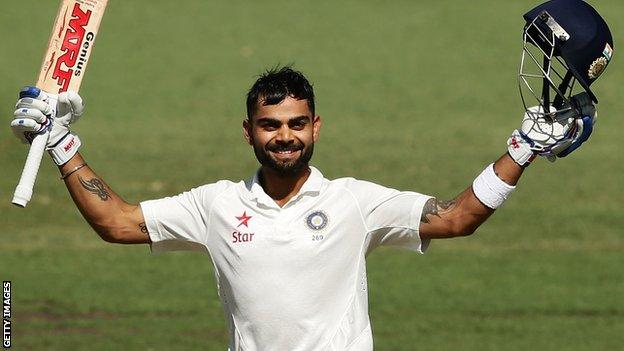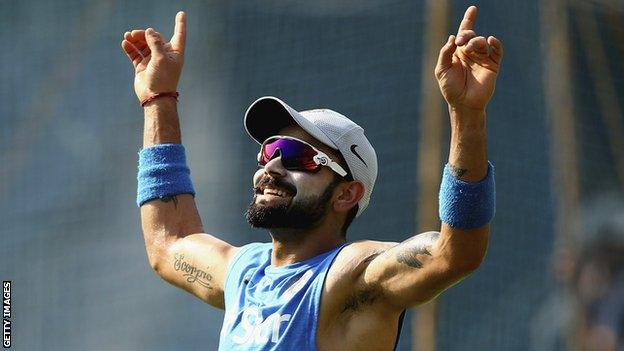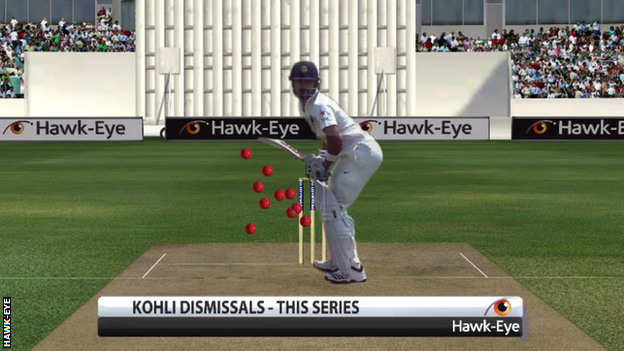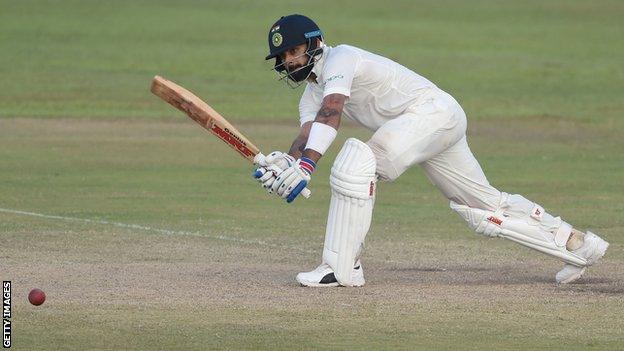England v India: Will Virat Kohli finally succeed in English conditions?
- Published

Virat Kohli's Test average of 53.40 is bettered by only Australia's Steve Smith among current players
Virat Kohli is the Cristiano Ronaldo of cricket.
Not only super-skilled, he is a man on a mission - to make both himself and his team the best in the world.
The intensity of both men's ambitions is obvious in their impassioned expressions and uber-commitment. Powered by an innate desire, they are their team's driving force. They play with a tangible emotion bordering on fury. Failure is not contemplated. Defeat is a personal insult.
But defeated India were the last time they toured England - in 2014 with MS Dhoni as captain - and Kohli had a miserable time, averaging only 13 with the bat. James Anderson had him on toast.
It is this experience, more than any other, that Kohli, now captain, is desperate to avenge. It is a huge blot on his otherwise excellent CV.
A series victory in England - confirming India as the number Test team - and a substantial number of runs from his bat on English pitches is Kohli's final frontier. He will leapfrog Steve Smith to become the world's best batsman if he achieves it.
From 'chubby' batsman to gluten-free gym bunny
Kohli was always a richly talented batsman who made hundreds in his early teens and in 2008 led India to victory in the Under-19 World Cup.
But for a long time he was labelled as mainly a one-day player. His Test average in his first 20 innings hovered around the mid-30s.
A pivotal moment was after a disappointing 2012 Indian Premier League season when he realised he was not fit enough.
"My training was horrible," he said. "I ate so bad, I was up until late, I was having a drink or two regularly. I came out of the shower one day and looked at myself in the mirror and said 'you can't look like this if you want to be a professional cricketer'.
"I was 11 or 12kg heavier than I am now; I was really chubby. I changed everything from the next morning from what I eat to how I train. I was in the gym for an hour and a half every day, working really hard, off gluten, off wheat, no cold drinks, no desserts, nothing. It was tough."

Kohli has scored 5,554 runs in Tests and 9,779 in ODIs
The results were significant in one-day cricket, where he reeled off a succession of match-winning innings, dominating the bowlers with imperious drives and pulls.
But his technique against the red ball was unpicked by the England seamers when he toured England for the first time in 2014.
He had a tendency to plant his front foot down the pitch and play at balls away from his body. Against the non-swinging white ball on flat one-day pitches, this is the way to power the ball to the boundary with a full follow-through.
But Anderson's radar-controlled movement with the red Duke ball exposed Kohli's imprecise footwork and bristling impetuosity. Seven times he was dismissed edging the ball to wicketkeeper or slips (four off Anderson) and he had a highest score of 39 in 10 innings. India lost the series 3-1.

Kohli managed only 134 runs in the 2014 Test series in England
Captain marvel
Inheriting the Test captaincy from Dhoni at the end of 2014, Kohli was a man on a mission.
India were the seventh-ranked Test team - just above Bangladesh - and he was the 15th best batsman. He upped his training regime again. This time he focused more on weight training with snatches and deadlifts. He built up his legs with colossal numbers of squats and implored his colleagues to do the same.
His phenomenal fitness levels have thrust him to exceptional levels of productivity. In the past two years he has averaged 91 in one-day internationals with 10 hundreds, many in successful pursuits of seemingly unattainable targets.
He is the fastest completer of twos - sprinting the 44 yards in under six seconds - in the game.
The strength in his legs also allows him to get unusually low to the ground when driving - almost sniffing the ball - which gives him more control in the shot.
In his first Test as captain, against Australia in Adelaide, Kohli scored a hundred in each innings.
Since officially taking charge, he has averaged 65 with the bat - he has made 14 hundreds - and India have lost only one series as they ascended to their number one ranking.
His success and fitness have given him unmistakable poise. He exudes self-confidence as he strides out to the middle, with just a hint of the swagger that the great West Indian Viv Richards possessed. It is quite un-Asian.
India legends like Sunil Gavaskar and Sachin Tendulkar did not quite have this overpowering presence at the wicket. It is partly for this reason that former India batsman Sanjay Manjrekar, now a leading commentator, believes Kohli can be India's greatest batsman of all time.
"His self-belief is the thing that makes him really stand out," says Manjrekar, who played 37 Tests between 1987 and 1996. "You won't see nerves or hesitation when he walks out to bat against Anderson.
"If a ball dismisses him, he looks down the wicket in total amazement as if it was all a mirage. That's just not supposed to happen, his expression seems to say."
How can England stop him?
Kohli's conversion rate of decent starts into substantial scores is exceptional. He has reached fifty 37 times in 112 Test innings. He has turned 21 of those fifties into hundreds. Only Don Bradman of the top Test run-scorers has a better ratio of hundreds per innings.
England captain Joe Root, by comparison, has turned only 13 of his 53 fifties into three figures (from 126 innings.)
You need to get Kohli early. England will know that he has a tendency to go hard at the ball outside off stump at the start of an innings - he is not a good leaver of the ball - and that is where they will focus their attention. More than a third of his Test dismissals have been edges caught by the wicketkeeper or slips.
As England seamer Stuart Broad said last week: "There's only a handful of players where your plans differ from aiming at the top of off stump. Kohli is not one. You look to take it away or run it back in from that line with the occasional bouncer."

Of Kohli's past 10 Test hundreds, six have been converted into double centuries, two have passed 150 and two were unbeaten
Because Kohli plants his front foot fractionally early, England's plan may well be to bowl a succession of deliveries just outside off stump, moving away trying to get the edge or draw him across his crease, then angle one in at middle stump hoping for an lbw as he plays round his front leg.
But he is wiser now than when he was last here and recently averaged 47 against the much-vaunted South Africa seam attack.
Will Kohli succeed in this series?
It depends how well Anderson and Stuart Broad bowl (it will be important for one of them to be on when Kohli comes in) and if there is any sideways movement off the pitch. Swing alone may not be enough.
It is vital to get Kohli to the crease inside the first 20 overs when the ball is still hard and shiny and the seam proud.
So the key for England's bowlers is to dispatch the India openers early. If they can then get at Kohli and keep his series average in the mid-30s they will probably win the series.
But if the India top three do their job and Kohli averages 50, it may be India who make off with the spoils. And he will be officially crowned as India's new king.